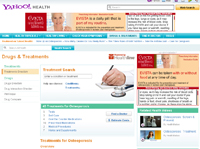Yahoo! expanded its Health offering, deepening content and offering three new search apps it says will enable advertisers to better reach target audiences, including through contextual advertising. The changes are part of an effort by the web portal, the third-most visited online health destination according to comScore, to cater to pharmaceutical and CPG sponsors, which include Schering-Plough Healthcare Products (Merck), AstraZeneca and Eli Lilly.
In April, Yahoo! partnered with technology firm Healthline Networks, whose semantic taxonomy powers the revamped portal’s new search-specific tools—symptom check, diagnosis search and doctor finder. Yahoo! hopes the applications, added to its editorial content, lead users to linger on the site and to increase engagement.
“We did our research,” said Damon Cronkey, Yahoo! senior director and regional business leader for Health. “The case for users in those applications is much deeper than for browsing content that’s editorially driven around healthy living and lifestyle. The sheer nature of spending time researching osteoporosis—if you want to dig into it—is much more engaging these days than simply reading about general, everyday health.”
Among new content features are a library of articles and videos and a set of daily blogs written by medical experts from Johns Hopkins Medical School, as well as by editors from Self and Men’s Health. Health calculators and risk-assessment tools round out the offering. The expanded content has been visible since May 27, but Yahoo! began consumer and media outreach on the revamped portal yesterday.
Yahoo! also became a partner in the Healthline’s health advertising network, enabling Healthline advertisers to run their display ads on the Yahoo! Health channel. (Given the nature of the category, Yahoo! said it offers guaranteed delivery on certain campaigns, meaning it works closely with health advertisers to define areas where they want to place ads.)
While symptom checkers abound across the web, Healthline’s search-based app “allows consumers to more conveniently and more quickly get the most relevant content they are looking for,” said Joe Petrocino, VP advertising sales, Healthline. “Vice versa, we allow publishers better clarity on user intent, which allows them to serve up a better, more appropriate ad.”
Being able to target consumers searching symptomatic content is desirable to advertisers, Yahoo! and Healthline say. The technology allows publishers to target by stage in the patient pathway—from checking symptoms to searching for treatments and finally searching for a provider. Yahoo!, however, is still trying to decide the best way to fully leverage the technology. “The ability is there to target treatment searches or symptom searches to contextual advertising, and we haven’t brought that to market yet,” said Cronkey.
Yahoo!, he continued, wants to provide more contextually relevant ad experiences but also wants to protect user privacy. “This is a very sensitive category,” he said. “We are ultra-focused on making sure we are taking care of our user interests as well as providing the best solution for advertisers.”
According to comScore, Yahoo! Health attracts more than 11 million unique visitors a month.








